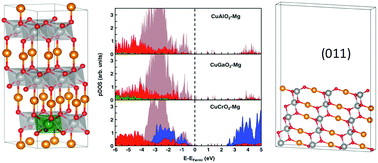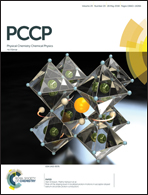An ab initio study of Cu-based delafossites as an alternative to nickel oxide in photocathodes: effects of Mg-doping and surface electronic features†
Abstract
CuMO2 delafossites (M = Al, Ga, and Cr) are p-type semiconductor oxides that have been recently proposed as the electrode in p-type dye-sensitized solar cells (p-DSSC) which is an alternative to the standard, low-performing nickel oxide. To assess this potential application of delafossites, we report here a DFT-based investigation of the structural and electronic properties of CuAlO2, CuGaO2 and CuCrO2. In particular, we address the role of Mg doping to obtain the p-type semiconducting character: the substitution of an M3+ cation with Mg2+ is easier with Ga than with Al and Cr, and, in all cases, the hole introduced by Mg2+ leads to the formation of Cu2+ species. Moreover, we address surface electronic features in order to characterize the most exposed delafossite surface termination and, more importantly, to predict the valence band maximum energy value, which determines the p-DSSC open circuit potential. From analysis of all our results, CuGaO2 emerges as the most promising system that can boost the development of new photocathodes for p-DSSCs.



 Please wait while we load your content...
Please wait while we load your content...